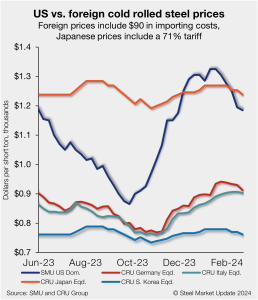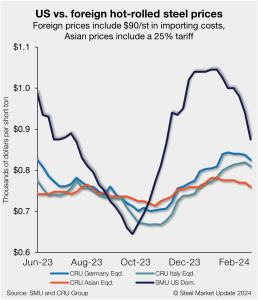
SMU survey: Steel mill lead times near 5-month low
Steel mill lead times shrunk by an average of 0.3 weeks, according to our latest market survey, now nearing levels last seen in September of last year.

Steel mill lead times shrunk by an average of 0.3 weeks, according to our latest market survey, now nearing levels last seen in September of last year.

Steel buyers generally found mills more willing to negotiate spot pricing on the products SMU surveys this week, according to our most recent survey data.

Mexico has said it will place retaliatory steel tariffs on the United States if the US acts to reimpose Section 232 on its neighbor, according to an article in Reuters.
What are some “Black Swans” to watch out for? With the war in Ukraine entering its third year, your mind might understandably move to conflicts overseas. Here is one closer to home to consider: US trade relations with Mexico taking a turn for the worse. I mention that because the Office of the United States Trade Representative (USTR) dropped a (virtual) bombshell earlier this month.
January’s import level was even higher than an earlier license count had suggested, making it the highest month for imports since June 2023.

Foreign cold-rolled coil (CR) remains much less expensive than domestic product even as prices in the US have declined at a rapid pace over the past month, according to SMU’s latest check of the market.
The United Steelworkers union expressed a lack of trust in assurances from Japan’s Nippon Steel Corp. (NSC) regarding its proposed buy of U.S. Steel.
Domestic production of raw steel moved up again last week, improving for the fourth straight week, according to the most recent data from the American Iron and Steel Institute (AISI).
Domestic prices have been sliding since the beginning of the year, and I don’t see any obvious reasons why the slide might stop this week. But let’s put the timing of a bottom aside for a minute. The question among some of you seems to be whether we’ll see another price spike, or at least a “dead-cat bounce,” before the typical summer doldrums kick in.

This week, the World Trade Organization (WTO) ministerial conference convenes in Abu Dhabi, UAE. There are many issues on the WTO’s plate. The question is whether any resolution of these matters is likely or even possible. One of the most important issues is the future of the dispute settlement system, which has been rendered impotent […]
Olympic Steel said it's open to future acquisitions in all three of its business segments.
US Trade Representative Katherine Tai has voiced the United States’ unease at a marked increase in steel and aluminum imports from Mexico, and what she termed a lack of transparency about Mexican imports of the metals from third countries.
Nippon Steel Corp.’s (NSC) operations in China are a potential security concern of the Biden administration, according to a Bloomberg report citing anonymous sources close to the matter.

Rig counts in the US and Canada were mixed again for the week ended Feb. 23. The US saw totals move higher, while Canadian rig figures slipped week on week (w/w), Baker Hughes’ latest data shows. US rigs The number of active rotary rigs in the US expanded by five to 626 from the previous […]
Global steel output moved up in January, recovering from consecutive declines in November and December, the World Steel Association (worldsteel) said in its latest monthly report.
SunCoke Energy Inc. announced the retirement of its current CEO and the appointment of a new leader on Friday.
In the period between mid-February and mid-March, CRU forecasts global demand for steelmaking raw materials to change little from the previous month,but buying activity will improve towards the end of next month
The US already had strict regulations on air-quality standards for particulate matter, but they are going to get even tighter.
At SMU, our goal is not to tell you what to think but to keep the conversation going. We asked you in our survey this week what you were seeing when it comes to steel prices, demand, imports, and wildcards. In your own words, with minimal editing, here’s what some of you in the SMU community shared with us this week.
I’ve had discussions with some of you lately about where and when sheet prices might bottom. Some of you say that hot-rolled (HR) coil prices won’t fall below $800 per short ton (st). Others tell me that bigger buyers aren’t interested unless they can get something that starts with a six. Obviously a lot depends on whether we're talking 50 tons or 50,000 tons. I've even gotten some guff about how the drop in US prices is happening only because we’re talking about it happening.
Olympic Steel’s earnings jumped in the fourth quarter, even as the company dealt with "significant" price volatility in hot rolled for full-year 2023.
Alan Kestenbaum, the CEO of Stelco, said the company is actively evaluating ways to grow the company, including both organic and inorganic opportunities.
Ryerson swung to a net profit in the fourth quarter, though revenue declined from the same period last year.
Having just attended the historically significant ISRI Mid-America Chapter Consumers Night Banquet in St. Louis and waiting for my delayed flight, it seemed I had the perfect opportunity to inform the industry of a few items that came out while wheeling and dealing in the beautiful Union Train Station Hotel. For the West Coast export […]

Over my years of observing the steel market, there's been a recurring belief that current market disruptions in either the physical spot market or steel futures are temporary anomalies, destined to fade, and that normalcy will soon return. However, the events of the first few weeks of 2024 served as a stark reminder that this expectation seldom materializes, and that the US steel market is still the most volatile steel market in the world.
Canada will soon require steel imports to report “country of melt and pour” information.

The premium US hot-rolled coil (HRC) held over offshore product is disappearing in a hurry. Domestic hot band prices continue to fall at a fast clip, erasing a nearly $300/st gap they had over imported HRC just two months ago. All told, US HRC prices are now 8.8% more expensive than imports. The premium is […]
Canadian steelmaker Stelco swung to a loss in the fourth quarter as revenue declined due to decreased shipping volume and average selling prices.
Steel Market Update’s Steel Demand Index has moved lower, having remained in contraction territory for the better part of the past two months, according to our latest survey data.
Falling steel prices at present are not a symptom of demand but of imports arriving into the US and to some parts of Mexico, Ternium’s CEO Maximo Vedoya said this week.